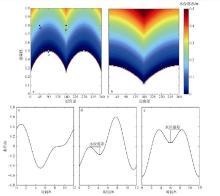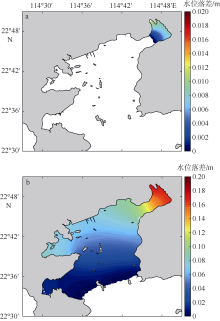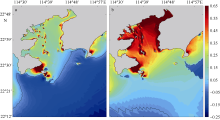| [1] |
WANG Xu, QU Ke, WANG Zijun, YANG Yuanping, WANG Chao, ZHANG Liangbin.
Numerical simulation study on the effect of wind on the hydrodynamic characteristics of undular tidal bores seawall
[J]. Journal of Tropical Oceanography, 2024, 43(5): 116-130.
|
| [2] |
WU Hongbo, LUO Feng, CHEN Zhipeng, ZHU Fei, ZENG Jingwei, ZHANG Chi, LI Ruijie.
A novel pattern for predicting the effects of mangrove ecological reconstruction
[J]. Journal of Tropical Oceanography, 2024, 43(4): 86-97.
|
| [3] |
XI Chen, LIN Zongxuan, SA Rula, DENG Xi, LIU Qiang, NI Liang, LUO Laicai, MA Teng, XIE Zhijie, CHEN Siruo, CHEN Songze.
Analysis of water environmental changes and influencing factors in the southwestern waters of the Daya Bay based on continuous monitoring data from dual buoys
[J]. Journal of Tropical Oceanography, 2024, 43(4): 153-164.
|
| [4] |
ZHANG Zheran, HU Junyang, ZHOU Kai, ZHANG Penghui, XING Jiuxing, CHEN Shengli.
Storm surge simulations of the coastal area of Shenzhen using different types of typhoon meteorological fields—a case study of Typhoon Mangkhut*
[J]. Journal of Tropical Oceanography, 2023, 42(6): 1-14.
|
| [5] |
SUN Cuici, YUE Weizhong, ZHAO Wenjie, WANG Youshao.
Distribution of the microbial Carbohydrate-Active enzymes genes in the surface sediment of the Daya Bay, China
[J]. Journal of Tropical Oceanography, 2023, 42(5): 76-91.
|
| [6] |
SONG Xingyu, LIN Yajun, ZHANG Liangkui, XIANG Chenhui, HUANG Yadong, ZHENG Chuanyang.
Distribution characteristics and influencing factors of meso- and micro-zooplankton communities in the offshore waters of the Guangdong-Hong Kong-Macao Greater Bay Area*
[J]. Journal of Tropical Oceanography, 2023, 42(3): 136-148.
|
| [7] |
ZHANG Min, WU Hangxing, LU Yibin, LU Diwen, MI Jie, ZHU Donglin, CHEN Bo.
Impact of the coastal reclamations on topography evolution in the Qinzhou Bay, Guangxi
[J]. Journal of Tropical Oceanography, 2023, 42(2): 124-131.
|
| [8] |
JIANG Xun, WU Wen, SONG Dehai.
Identification and quantitative analysis of key controlling factors of water quality response to human activities in the Daya Bay, China
[J]. Journal of Tropical Oceanography, 2023, 42(1): 182-191.
|
| [9] |
GU Jinghua, ZHU Jianrong, JIN Zhi.
Numerical simulation of oil film drift and diffusion after oil spill accident at the Baosteel wharf in the Changjiang Estuary
[J]. Journal of Tropical Oceanography, 2022, 41(6): 159-170.
|
| [10] |
CHEN Jingfu, ZHONG Yu, WANG Lei, GUO Yupei, QIU Dajun.
Noctiluca scintillans effects on eukaryotic plankton community structure using Environmental DNA analysis in Daya Bay*
[J]. Journal of Tropical Oceanography, 2022, 41(5): 121-132.
|
| [11] |
ZHANG Wanru, LIU Qingxia, HUANG Honghui, QIN Xiaoqing, LI Jiajun, CHEN Jianhua.
Study on stable isotopes of carbon and nitrogen of main fishery organisms in the southwestern waters of Daya Bay, South China Sea in winter 2020
[J]. Journal of Tropical Oceanography, 2022, 41(3): 147-155.
|
| [12] |
LI Yao, XIANG Chenhui, JIANG Zhijian, SONG Xingyu.
Production and metabolism characteristics of planktonic community and their influencing factors in Daya Bay during summer*
[J]. Journal of Tropical Oceanography, 2021, 40(6): 83-92.
|
| [13] |
WANG Renzheng, SHAN Zhengduo, MENG Siyu, GONG Xiang.
Interannual variation of subsurface chlorophyll maximum in the northern South China Sea
[J]. Journal of Tropical Oceanography, 2021, 40(6): 63-75.
|
| [14] |
XIANG Chenhui, LIU Jiaxing, KE Zhixin, ZHOU Linbin, TAN Yehui.
Phytoplankton responses to Dan’ao River estuary water enrichment in terms of size structure and community composition*
[J]. Journal of Tropical Oceanography, 2021, 40(2): 49-60.
|
| [15] |
ZHANG Hua, WEN Xixi, PENG Shiqiu.
Numerical simulation of barotropic tides in Mozambique Strait and its adjacent coastal area and energy budget analysis*
[J]. Journal of Tropical Oceanography, 2021, 40(2): 7-16.
|
 ), Wen WU2, Dehai SONG1(
), Wen WU2, Dehai SONG1( ), Xianwen BAO1,2
), Xianwen BAO1,2



















